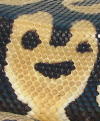» Site Navigation

1 members and 647 guests
Most users ever online was 47,180, 07-16-2025 at 05:30 PM.
» Today's Birthdays

» Stats

Members: 75,937
Threads: 249,129
Posts: 2,572,288
Top Poster: JLC (31,651)
|
-
An update and some interesting egg studies.
I wanted to put someintersting information all in one post, so here it goes. First of all, I wanted to give an update on the egg that I tore when they were laid. After a little over 2 weeks into incubation, the egg looks great, and seems to have healedover, as it has absorbed some water, and is as full as the other eggs. I will give another update in about 3 weeks, when I candle the eggs.
The other part of the title, is an interesting question that has bugged me. Well I decided to dosomething about it this year. I will post the results of the "study" after the clutch hatches, but here is the overveiw of what I amdoing.
I talked about a theory with a buddy of mine last year regarding kinking in Caramels. His theory is that Caramels have week spines. alot of peopple have said over the years that if you incubate Caramel eggs a bit drier, they have less of a tendancy to kink. My buddies theory is that by incubating the eggs drier, the egg incubated partially dented throughout the entir incubation process, and therefore has less pressure inside the egg. Having less pressure in the egg puts less pressure on the spine, and therefore gives you a better chance at hatching a Caramel with no kinks.
AsI stated, this is just a theory, but I have been trying to find a way to put some numbers to it (mostly because I am a data guy, and love numbers). What I am doing this year is as follows. I weighed one of our eggs from Caramel to Het this year. I am weighing the egg every week, and noting the change in weight. After the egg hatches, I will we the hatchling, weigh the dried eggshell, weigh any remaining yolk, and weigh the fluid in the egg (in an attempt to obtain the specific gravity of the fluid). I will then back calculate in an attempt to determine what percent of water is absorbed and released throughout incubation. Hopefully this will appease my curiosity, until I can find some type of meter with a probe small enough to insertin an egg tomeasure the internal egg pressure.
I thought this was neat, and it may bore everyone else, but I thought I would post it in case anyone was interested.
I hope everyone is having as much fun this season as we are,
-
-
Re: An update and some interesting egg studies.
Tim,
I look forward to seeing what your findings are! I remember you discussing this in Birmingham!
-
-
BPnet Veteran


Re: An update and some interesting egg studies.
Tim -
That is an interesting theory -- look forward to hearing the results -- tho between you and I -- I'm not sure I'd want to buy a ball with a weak spine -- even if it's not kinked. 
-
-
BPnet Veteran


Re: An update and some interesting egg studies.
HI Tim, interesting hypothesis.
The only problem I see is that the pressure should be relatively equally distributed within the egg. So no matter whether it's high or low, it shouldn't push the spine in any given direction and kink it.
JonV
-
-
Re: An update and some interesting egg studies.
 Originally Posted by nevohraalnavnoj

HI Tim, interesting hypothesis.
The only problem I see is that the pressure should be relatively equally distributed within the egg. So no matter whether it's high or low, it shouldn't push the spine in any given direction and kink it.
JonV
Jon,
That is a very intersting point you bring up. However, if the spine is weak, and the pressure in the egg is high (and evenly distributed), it could still potentially "crush" the weakest part of the spine and kink it. It is always going to be a hypothesis, until the scientific community could share some of their high dollar facilities to really study it. I am like many others, in that I just want to try and eliminate any possible chance, if it is possible. Plus, it interests me to dig as much as I can.
-
-
BPnet Veteran


Re: An update and some interesting egg studies.
I wonder if one could make a list of everything that causes spine kinks in humans as well as known causes in other animals and contrast this with any possible causes in the caramel gene?
JonV
-
-
Re: An update and some interesting egg studies.
Hi,
Is it related to the amount of calcium available to the hatchling? I.e. instead of being abnormal embryo development the genes for caramel inhibit calcium being passed from the mother?
Was just curious if a calcium booster to the female would have any effect on the egg development in that case or not.
dr del
Derek
7 adult Royals (2.5), 1.0 COS Pastel, 1.0 Enchi, 1.1 Lesser platty Royal python, 1.1 Black pastel Royal python, 0.1 Blue eyed leucistic ( Super lesser), 0.1 Piebald Royal python, 1.0 Sinaloan milk snake 1.0 crested gecko and 1 bad case of ETS. no wife, no surprise.
-
-
Re: An update and some interesting egg studies.
Thats actually an excellent proposal. I will be waiting excited for these results.
A+
Last edited by Patrick Long; 06-16-2008 at 10:36 PM.
-
-
Re: An update and some interesting egg studies.
Jon and Derek, Thanks for the additional thought. I always love to think about the less thought of things. I had never thought of those 2 things. However, both of them seem only to apply if my hypothesis is correct.
-
-
BPnet Veteran


Re: An update and some interesting egg studies.
Have you had a the kinked portion of a carmel x-rayed? It should be fairly inexpensive if your vet will work with you. Or you might be able to talk your local x-ray tech program/medical/vet college in to helping out with an x-ray.
I am just curious, if the kink is a crushed portion due to pressure or some other physical factor.
Sounds interesting I can't wait to hear the out come.
Good Luck!
-
 Posting Permissions
Posting Permissions
- You may not post new threads
- You may not post replies
- You may not post attachments
- You may not edit your posts
-
Forum Rules
|









 Reply With Quote
Reply With Quote



